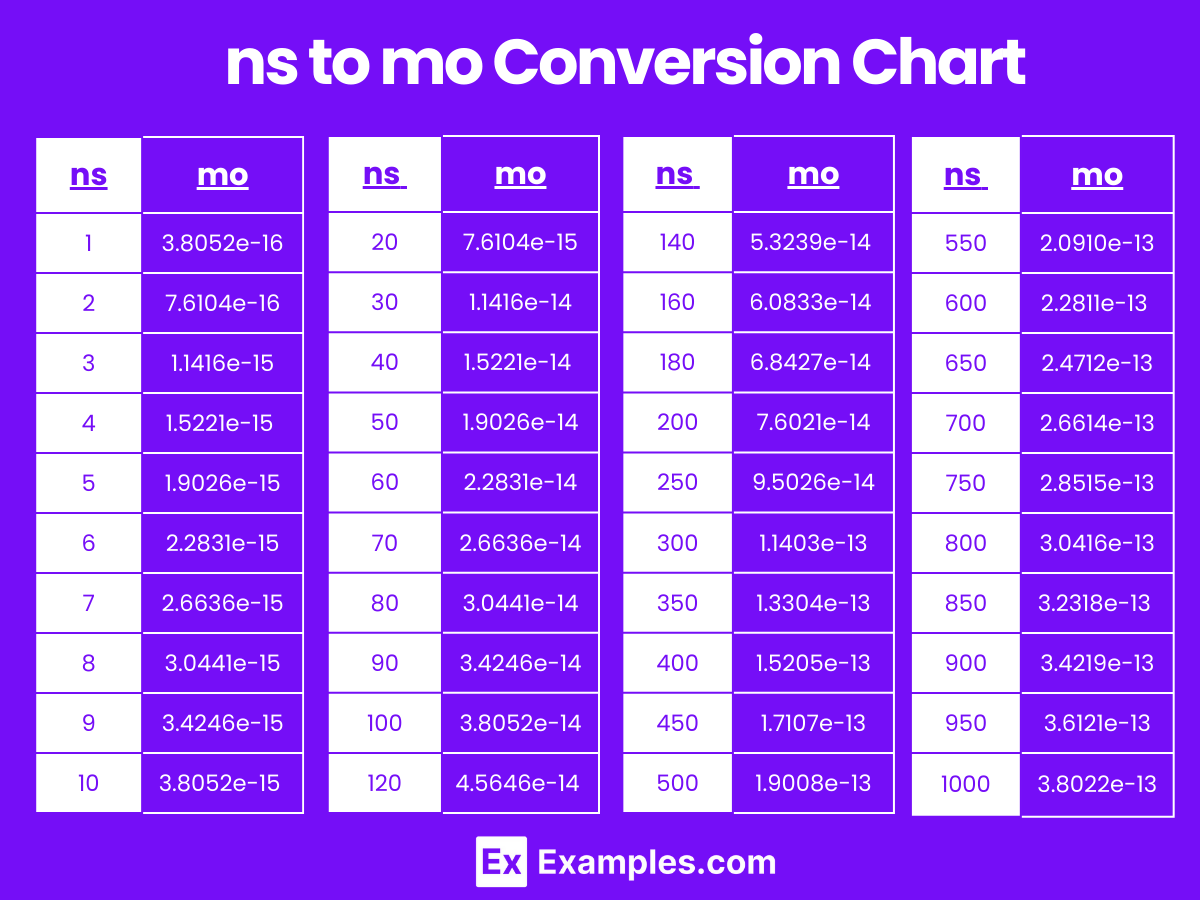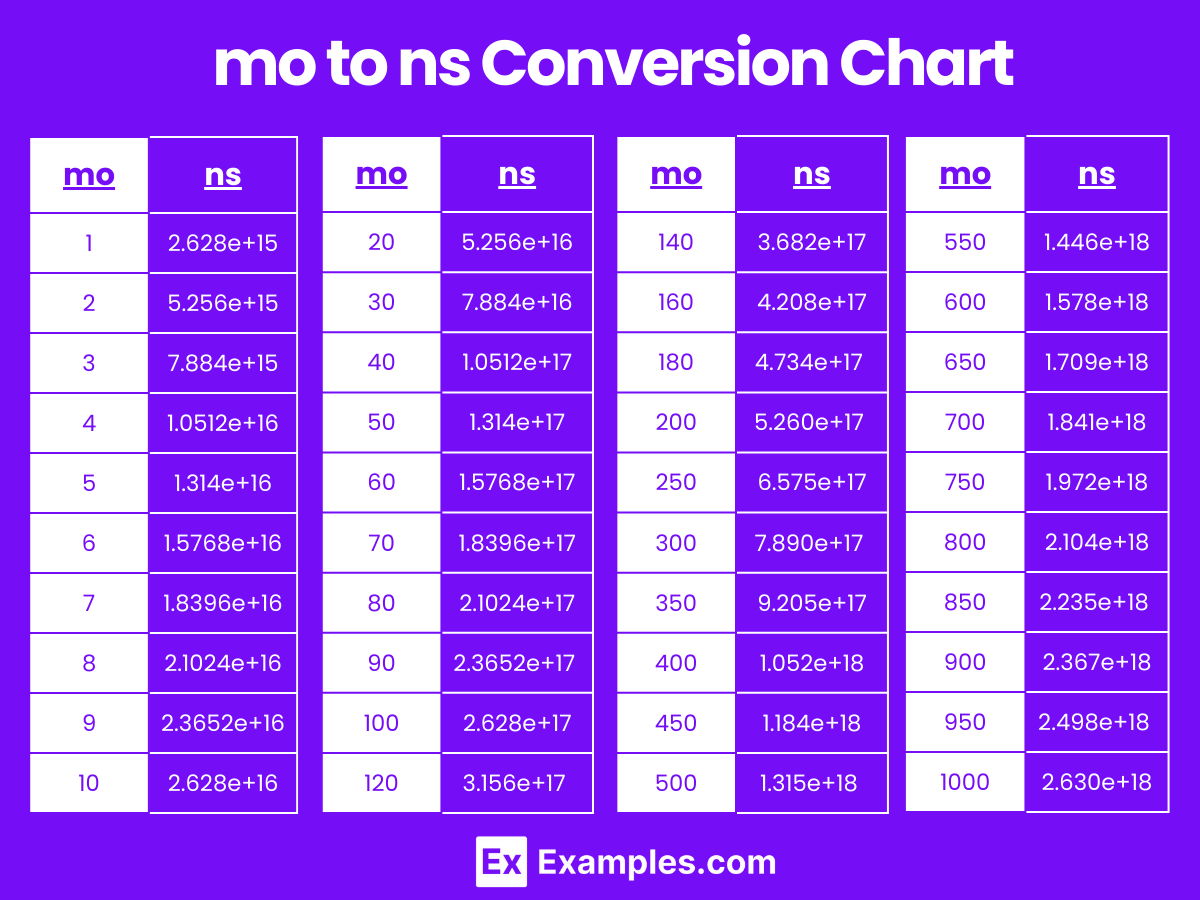Quickly and accurately convert nanoseconds to months and vice versa on Examples.com. Simply input your figures to get immediate results.
Time Converters to Nanosecond (nm)
Time Converters to Month (mo)
| Nanosecond to Month | Microsecond to Month | Millisecond to Month |
| Second to Month | Minute to Month | Hour to Month |
| Day to Month | Week to Month | Calendar Year to Month |
| Decade to Month | Century to Month |
Conversion Factors:
- Nanoseconds to Months: 1 month = 2,628,000,000,000,000 nanoseconds.
- Months to Nanoseconds: 1 nanosecond = 1/2,628,000,000,000,000 months.
How to Convert Nanoseconds to Months:
To convert nanoseconds to months, divide the number of nanoseconds by 2,628,000,000,000,000.
Months=Nanoseconds/2,628,000,000,000,000
Example:
Convert 5,000,000,000,000,000 nanoseconds to months.
Months=5,000,000,000,000,000/2,628,000,000,000,000=1.90 months
How to Convert Months to Nanoseconds:
To convert months to nanoseconds, multiply the number of months by 2,628,000,000,000,000.
Nanoseconds=Months×2,628,000,000,000,000
Example:
Convert 2 months to nanoseconds.
Nanoseconds=2×2,628,000,000,000,000=5,256,000,000,000,000 nanoseconds
Nanoseconds to Months Conversion Table
| Nanoseconds (ns) | Months (mo) |
|---|---|
| 1 ns | 3.8052e-16 mo |
| 2 ns | 7.6104e-16 mo |
| 3 ns | 1.1416e-15 mo |
| 4 ns | 1.5221e-15 mo |
| 5 ns | 1.9026e-15 mo |
| 6 ns | 2.2831e-15 mo |
| 7 ns | 2.6636e-15 mo |
| 8 ns | 3.0441e-15 mo |
| 9 ns | 3.4246e-15 mo |
| 10 ns | 3.8052e-15 mo |
| 20 ns | 7.6104e-15 mo |
| 30 ns | 1.1416e-14 mo |
| 40 ns | 1.5221e-14 mo |
| 50 ns | 1.9026e-14 mo |
| 60 ns | 2.2831e-14 mo |
| 70 ns | 2.6636e-14 mo |
| 80 ns | 3.0441e-14 mo |
| 90 ns | 3.4246e-14 mo |
| 100 ns | 3.8052e-14 mo |
ns to mo Conversion Chart

Months to Nanoseconds Conversion Table
| Months (mo) | Nanoseconds (ns) |
|---|---|
| 1 mo | 2.628e+15 ns |
| 2 mo | 5.256e+15 ns |
| 3 mo | 7.884e+15 ns |
| 4 mo | 1.0512e+16 ns |
| 5 mo | 1.314e+16 ns |
| 6 mo | 1.5768e+16 ns |
| 7 mo | 1.8396e+16 ns |
| 8 mo | 2.1024e+16 ns |
| 9 mo | 2.3652e+16 ns |
| 10 mo | 2.628e+16 ns |
| 20 mo | 5.256e+16 ns |
| 30 mo | 7.884e+16 ns |
| 40 mo | 1.0512e+17 ns |
| 50 mo | 1.314e+17 ns |
| 60 mo | 1.5768e+17 ns |
| 70 mo | 1.8396e+17 ns |
| 80 mo | 2.1024e+17 ns |
| 90 mo | 2.3652e+17 ns |
| 100 mo | 2.628e+17 ns |
mo to ns Conversion Chart

Difference Between Nanoseconds to Months
| Aspect | Nanoseconds | Months |
|---|---|---|
| Definition | A nanosecond is one billionth of a second, used primarily to measure time in scientific and electronic contexts. | A month is a unit of time used in calendars, roughly corresponding to the period of the lunar cycle, approximately 30.44 days long. |
| Usage | Commonly used in physics, chemistry, and computing to measure extremely fast events. | Widely used in business, education, and personal planning to organize and schedule events over longer periods. |
| Scale | Extremely small, suitable for measuring time intervals in high-speed systems. | Much larger, suitable for tracking long-term durations and cycles. |
| Precision | Provides very high precision for brief durations, suitable for scientific experiments and precise technology operations. | Less precise on a daily basis, more aligned with human-scale activities and natural cycles. |
| Conversion Complexity | Converting to and from nanoseconds often involves large exponential factors due to its small scale. | Conversion involves more straightforward multiplicative factors based on average days per month. |
| Context of Relevance | Critical in fields like telecommunications, computing, and physics where rapid processes occur. | Essential in administrative, legal, and social contexts where monthly cycles are significant. |
| Physical Representation | Cannot be physically perceived due to its minuscule duration; only measurable with electronic instruments. | Easily observed and experienced through natural phenomena like the changing of seasons and phases of the moon. |
| Typical Measurement Tools | High-speed electronic clocks and specialized scientific instruments. | Standard calendars, software applications, and simple calculations. |
1. Solved Examples on Converting Nanoseconds to Months
Example 1:
Problem: Convert 1,000,000,000,000 nanoseconds to months.
Solution: Months=1,000,000,000,000 ns/2,628,000,000,000,000=0.00038052 months
Example 2:
Problem: Convert 50,000,000,000,000 nanoseconds to months.
Solution: Months=50,000,000,000,000 ns/2,628,000,000,000,000=0.019026 months
Example 3:
Problem: Convert 500,000,000,000 nanoseconds to months.
Solution: Months=500,000,000,000 ns/2,628,000,000,000,000=0.00019026 months
Example 4:
Problem: Convert 12,500,000,000,000,000 nanoseconds to months.
Solution: Months=12,500,000,000,000,000 ns/2,628,000,000,000,000=4.7561 months
Example 5:
Problem: Convert 2,628,000,000,000,000 nanoseconds to months.
Solution: Months=2,628,000,000,000,000 ns/2,628,000,000,000,000=1 month
2. Solved Examples on Converting Months to Nanoseconds
Example 1:
Problem: Convert 0.5 months to nanoseconds.
Solution: Nanoseconds=0.5×2,628,000,000,000,000=1,314,000,000,000,000 ns
Result: 0.5 months is equal to 1,314,000,000,000,000 nanoseconds.
Example 2:
Problem: Convert 1 month to nanoseconds.
Solution: Nanoseconds=1×2,628,000,000,000,000=2,628,000,000,000,000 ns
Result: 1 month is equal to 2,628,000,000,000,000 nanoseconds.
Example 3:
Problem: Convert 2 months to nanoseconds.
Solution: Nanoseconds=2×2,628,000,000,000,000=5,256,000,000,000,000 ns
Result: 2 months is equal to 5,256,000,000,000,000 nanoseconds.
Example 4:
Problem: Convert 3 months to nanoseconds.
Solution: Nanoseconds=3×2,628,000,000,000,000=7,884,000,000,000,000 ns
Result: 3 months is equal to 7,884,000,000,000,000 nanoseconds.
Example 5:
Problem: Convert 10 months to nanoseconds.
Solution: Nanoseconds=10×2,628,000,000,000,000=26,280,000,000,000,000 ns
Result: 10 months is equal to 26,280,000,000,000,000 nanoseconds.
How accurate is the conversion from nanoseconds to months?
The conversion is based on an average month length and is fairly accurate for approximate calculations. However, for precise scientific calculations, the exact number of days in specific months and leap years might need to be considered.
Why is the conversion factor from nanoseconds to months so large?
The conversion factor is large because a nanosecond is a very small unit of time compared to a month. A month encompasses millions of seconds, whereas a nanosecond is a billionth of a single second.
What tools can I use to convert nanoseconds to months?
You can use online converters or calculators, or simply apply the conversion formula manually as shown in the FAQs. Some scientific calculators and software also offer functions to convert different units of time.
Why is it important to convert nanoseconds to months in scientific research?
In scientific research, converting nanoseconds to months can help researchers understand and present the duration of certain phenomena or experiments in a more comprehensible scale related to human time perception.
Are there tools that can automatically convert nanoseconds to months for large datasets?
Yes, software like Excel, programming languages like Python, and various data analysis tools can perform batch conversions of nanoseconds to months, which is useful for processing large datasets in scientific and technological research.
How does leap year affect the conversion from nanoseconds to months?
Leap years add an extra day to February, slightly altering the average length of a month when calculating over multiple years. This might require adjustments in high-precision scientific calculations.

